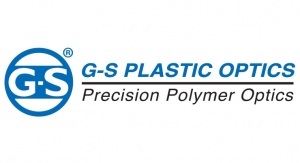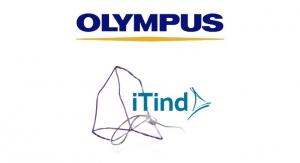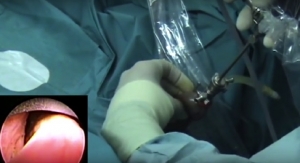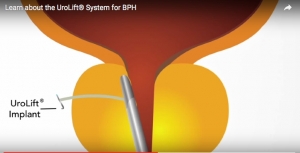Videos
New Data on Minimally Invasive Prostate Treatment Technology from NeoTract
New Data on Minimally Invasive Prostate Treatment Technology from NeoTract
Data show favorable results for UroLift implant compared to standard TURP procedure.
09.04.15
NeoTract Inc.'s prostate treatment implant -- the UroLift System -- provides significant, durable symptom relief, improves urinary flow rates and preserves sexual function, two studies of the technology confirm.
“These results confirm the long-term benefits of the UroLift System and show that it is an alternative to the procedure that has been the standard of care for decades,” President/CEO Dave Amerson said. “We are proud to bring rapid relief to patients suffering from BPH [Benign Prostatic Hyperplasia], and to provide a safe, effective and easy treatment alternative to physicians who care for them.”
The BPH6 clinical study, which enrolled 80 patients at 10 European centers, was the first randomized comparison between UroLift and surgical transurethral resection of the prostate (TURP), the most common BPH procedure, in which the inner portion of the prostate is surgically removed. When assessed for overall improvement, defined as improving lower urinary tract symptoms without diminishing sexual function, continence or safety, patients treated with the UroLift device responded more consistently than those treated with TURP, according to the company. In addition, patient satisfaction rose more quickly for those treated with the UroLift device and was sustained to one year.
“BPH6 is a landmark study that shows that the minimally invasive UroLift device compares very well to TURP, the gold standard, with regard to efficacy, and is superior to TURP at preserving sexual function and offering a more rapid recovery,” said Neil Barber, M.D., consultant urological surgeon at Frimley Park Hospital NHS Foundation Trust in Frimley, United Kingdom. “These results provide additional evidence that continue to validate the recently published European Association of Urology guidelines giving UroLift a positive recommendation for the treatment of men with BPH.”
International prostate symptom score (IPSS) improvement was significant for both UroLift (-11.4±8.4) and TURP (-15.4±6.8) at 12 months, while quality of life improvements were not different between groups. 52.3 percent of UroLift patients responded to all six endpoints, vs 20 percent of TURP patients (p=0.005). At one month after treatment, 86 percent of UroLift patients would recommend the procedure to a friend or relative whereas only 73 percent of TURP patients would recommend the procedure.
The company also shared three-year results from the 206-patient L.I.F.T. IDE Study, a multi-center, randomized, blinded study of the UroLift System for patients with BPH. Claus Roehrborn, M.D., professor and chair of the Department of Urology UT Southwestern Medical Center in Dallas, and co-principal investigator for the L.I.F.T. clinical program, said the trial data demonstrate preserved sexual function and improvement in symptoms, flow and quality of life sustained to three years.
“These results show that the UroLift system treatment not only offers rapid improvement, but also durable relief for patients with BPH,” said Roehrborn. “After three years, patients treated with the UroLift device continue to experience symptom relief with minimal side effects, with few patients requiring an additional procedure for symptom relief.”
The analysis from the L.I.F.T. study shows an 88 percent superiority of treatment (n=140) over control (n=66) at three months and a sustained therapeutic effect in the UroLift implanted patients at three years. IPSS reduction was 44 percent by one month and sustained at 41 percent through three years (p-value < 0.0001). Adverse events were typically mild and transient, with the most frequent being hematuria, dysuria, pelvic pain, urgency and urge incontinence. Sexual function was preserved with no incidence of de novo, sustained erectile or ejaculatory adverse events. There was a low incidence of retreatment for lower urinary tract symptoms, with only 15 subjects seeking an additional procedure over the course of three years.
BPH, also known as enlarged prostate, is a medical condition in which the prostate gland that surrounds the male urethra becomes enlarged with advancing age and begins to obstruct the urinary system. The condition is common, affecting approximately 37 million men in the United States, industry statistics show. BPH symptoms include sleepless nights and urinary problems, and can cause loss of productivity, depression and decreased quality of life. About one in four men experience BPH-related symptoms by age 55 and by age 70, over 80 percent of men suffer from BPH.
Medication is often the first-line therapy for enlarged prostate, but relief can be inadequate and temporary. Side effects of treatment can include sexual dysfunction, dizziness and headaches, prompting many patients to quit using the drugs. For these patients, the classic alternative is surgery that cuts or ablates prostate tissue to open the blocked urethra. While current surgical options, such TURP can be very effective in relieving symptoms, it can also leave patients with permanent side effects such as urinary incontinence, erectile dysfunction and retrograde ejaculation (dry orgasm).
The U.S. Food and Drug Administration -cleared UroLift System is a novel, minimally invasive technology for treating lower urinary tract symptoms due to BPH. The UroLift permanent implants, delivered during a minimally invasive transurethral outpatient procedure, relieve prostate obstruction and open the urethra directly without cutting, heating, or removing prostate tissue. The UroLift System is available in the United States, Europe, Australia and Canada.
Based in Pleasanton, Calif., NeoTract develops minimally invasive urological treatment devices.
An animation of the UroLift System can be viewed below:
“These results confirm the long-term benefits of the UroLift System and show that it is an alternative to the procedure that has been the standard of care for decades,” President/CEO Dave Amerson said. “We are proud to bring rapid relief to patients suffering from BPH [Benign Prostatic Hyperplasia], and to provide a safe, effective and easy treatment alternative to physicians who care for them.”
The BPH6 clinical study, which enrolled 80 patients at 10 European centers, was the first randomized comparison between UroLift and surgical transurethral resection of the prostate (TURP), the most common BPH procedure, in which the inner portion of the prostate is surgically removed. When assessed for overall improvement, defined as improving lower urinary tract symptoms without diminishing sexual function, continence or safety, patients treated with the UroLift device responded more consistently than those treated with TURP, according to the company. In addition, patient satisfaction rose more quickly for those treated with the UroLift device and was sustained to one year.
“BPH6 is a landmark study that shows that the minimally invasive UroLift device compares very well to TURP, the gold standard, with regard to efficacy, and is superior to TURP at preserving sexual function and offering a more rapid recovery,” said Neil Barber, M.D., consultant urological surgeon at Frimley Park Hospital NHS Foundation Trust in Frimley, United Kingdom. “These results provide additional evidence that continue to validate the recently published European Association of Urology guidelines giving UroLift a positive recommendation for the treatment of men with BPH.”
International prostate symptom score (IPSS) improvement was significant for both UroLift (-11.4±8.4) and TURP (-15.4±6.8) at 12 months, while quality of life improvements were not different between groups. 52.3 percent of UroLift patients responded to all six endpoints, vs 20 percent of TURP patients (p=0.005). At one month after treatment, 86 percent of UroLift patients would recommend the procedure to a friend or relative whereas only 73 percent of TURP patients would recommend the procedure.
The company also shared three-year results from the 206-patient L.I.F.T. IDE Study, a multi-center, randomized, blinded study of the UroLift System for patients with BPH. Claus Roehrborn, M.D., professor and chair of the Department of Urology UT Southwestern Medical Center in Dallas, and co-principal investigator for the L.I.F.T. clinical program, said the trial data demonstrate preserved sexual function and improvement in symptoms, flow and quality of life sustained to three years.
“These results show that the UroLift system treatment not only offers rapid improvement, but also durable relief for patients with BPH,” said Roehrborn. “After three years, patients treated with the UroLift device continue to experience symptom relief with minimal side effects, with few patients requiring an additional procedure for symptom relief.”
The analysis from the L.I.F.T. study shows an 88 percent superiority of treatment (n=140) over control (n=66) at three months and a sustained therapeutic effect in the UroLift implanted patients at three years. IPSS reduction was 44 percent by one month and sustained at 41 percent through three years (p-value < 0.0001). Adverse events were typically mild and transient, with the most frequent being hematuria, dysuria, pelvic pain, urgency and urge incontinence. Sexual function was preserved with no incidence of de novo, sustained erectile or ejaculatory adverse events. There was a low incidence of retreatment for lower urinary tract symptoms, with only 15 subjects seeking an additional procedure over the course of three years.
BPH, also known as enlarged prostate, is a medical condition in which the prostate gland that surrounds the male urethra becomes enlarged with advancing age and begins to obstruct the urinary system. The condition is common, affecting approximately 37 million men in the United States, industry statistics show. BPH symptoms include sleepless nights and urinary problems, and can cause loss of productivity, depression and decreased quality of life. About one in four men experience BPH-related symptoms by age 55 and by age 70, over 80 percent of men suffer from BPH.
Medication is often the first-line therapy for enlarged prostate, but relief can be inadequate and temporary. Side effects of treatment can include sexual dysfunction, dizziness and headaches, prompting many patients to quit using the drugs. For these patients, the classic alternative is surgery that cuts or ablates prostate tissue to open the blocked urethra. While current surgical options, such TURP can be very effective in relieving symptoms, it can also leave patients with permanent side effects such as urinary incontinence, erectile dysfunction and retrograde ejaculation (dry orgasm).
The U.S. Food and Drug Administration -cleared UroLift System is a novel, minimally invasive technology for treating lower urinary tract symptoms due to BPH. The UroLift permanent implants, delivered during a minimally invasive transurethral outpatient procedure, relieve prostate obstruction and open the urethra directly without cutting, heating, or removing prostate tissue. The UroLift System is available in the United States, Europe, Australia and Canada.
Based in Pleasanton, Calif., NeoTract develops minimally invasive urological treatment devices.
An animation of the UroLift System can be viewed below:
Related Searches:


















